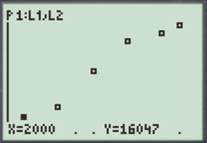
Concept explainers
(a)
To graph: A
(a)
Explanation of Solution
Given information:
The table given below shows the population of Florida in several years:
| Population of Florida | |
| Year | Population(in thousands) |
| 2000 | 16,047 |
| 2002 | 16,341 |
| 2004 | 17,314 |
| 2006 | 18,019 |
| 2008 | 18,328 |
| 2009 | 18,538 |
Graph:
To graph the points on scatter plot, follow the steps using graphing calculator.
First press the
Go to
Now, press the

Figure (1)
Interpretation: From the scatter plot of give data of population it can be observed that the population of Florida is increasing every year.
(b)
To find: The slope of the secant line
(b)
Answer to Problem 51RE
The slopes of the secant line
Explanation of Solution
Given information:
The table given below shows the population of Florida in several years:
| Population of Florida | |
| Year | Population(in thousands) |
| 2000 | 16,047 |
| 2002 | 16,341 |
| 2004 | 17,314 |
| 2006 | 18,019 |
| 2008 | 18,328 |
| 2009 | 18,538 |
The point
Calculation:
Simplify the slope of the secant line
So, the slope of the secant line
Simplify the slope of the secant line
So, the slope of the secant line
Simplify the slope of the secant line
So, the slope of the secant line
Therefore, the slopes of the secant line
(c)
To find: The average rates of change from
(c)
Answer to Problem 51RE
The average rate of change in the population of the given data is 244,800.
Explanation of Solution
Given information:
The table given below shows the population of Florida in several years:
| Population of Florida | |
| Year | Population(in thousands) |
| 2000 | 16,047 |
| 2002 | 16,341 |
| 2004 | 17,314 |
| 2006 | 18,019 |
| 2008 | 18,328 |
| 2009 | 18,538 |
The point
Calculation:
The slopes of the secant line
Therefore, the average rate of change in the population of the given data is 244,800.
(d)
To find: The instantaneous rate of change of population on July 1, 2009.
(d)
Answer to Problem 51RE
The instantaneous rate of change of population on July 1, 2009 is 210,000.
Explanation of Solution
Given information:
The table given below shows the population of Florida in several years:
| Population of Florida | |
| Year | Population(in thousands) |
| 2000 | 16,047 |
| 2002 | 16,341 |
| 2004 | 17,314 |
| 2006 | 18,019 |
| 2008 | 18,328 |
| 2009 | 18,538 |
Calculation:
The slope of the secant line from year 2009 to 2000 is 210. The average rate of change in the population of the given data is 210,000.
Therefore, the instantaneous rate of change of population on July 1, 2009 is 210,000.
(e)
To find: The estimated population of Florida in 2020.
(e)
Answer to Problem 51RE
The estimated population of Florida in 2020 is 442738.
Explanation of Solution
Given information:
The table given below shows the population of Florida in several years:
| Population of Florida | |
| Year | Population(in thousands) |
| 2000 | 16,047 |
| 2002 | 16,341 |
| 2004 | 17,314 |
| 2006 | 18,019 |
| 2008 | 18,328 |
| 2009 | 18,538 |
Calculation:
Consider that the population growth is liner function. The formula for a linear equation in slope-intercept form is:
The required equation is:
Substitute 2020 for x in the above equation to find the population in 2020,
Therefore, the estimated population of Florida in 2020 is 442738.
Chapter 2 Solutions
Calculus 2012 Student Edition (by Finney/Demana/Waits/Kennedy)
Additional Math Textbook Solutions
Single Variable Calculus: Early Transcendentals (2nd Edition) - Standalone book
Calculus: Early Transcendentals (3rd Edition)
Precalculus (10th Edition)
Calculus and Its Applications (11th Edition)
Precalculus: Concepts Through Functions, A Unit Circle Approach to Trigonometry (4th Edition)
 Calculus: Early TranscendentalsCalculusISBN:9781285741550Author:James StewartPublisher:Cengage Learning
Calculus: Early TranscendentalsCalculusISBN:9781285741550Author:James StewartPublisher:Cengage Learning Thomas' Calculus (14th Edition)CalculusISBN:9780134438986Author:Joel R. Hass, Christopher E. Heil, Maurice D. WeirPublisher:PEARSON
Thomas' Calculus (14th Edition)CalculusISBN:9780134438986Author:Joel R. Hass, Christopher E. Heil, Maurice D. WeirPublisher:PEARSON Calculus: Early Transcendentals (3rd Edition)CalculusISBN:9780134763644Author:William L. Briggs, Lyle Cochran, Bernard Gillett, Eric SchulzPublisher:PEARSON
Calculus: Early Transcendentals (3rd Edition)CalculusISBN:9780134763644Author:William L. Briggs, Lyle Cochran, Bernard Gillett, Eric SchulzPublisher:PEARSON Calculus: Early TranscendentalsCalculusISBN:9781319050740Author:Jon Rogawski, Colin Adams, Robert FranzosaPublisher:W. H. Freeman
Calculus: Early TranscendentalsCalculusISBN:9781319050740Author:Jon Rogawski, Colin Adams, Robert FranzosaPublisher:W. H. Freeman
 Calculus: Early Transcendental FunctionsCalculusISBN:9781337552516Author:Ron Larson, Bruce H. EdwardsPublisher:Cengage Learning
Calculus: Early Transcendental FunctionsCalculusISBN:9781337552516Author:Ron Larson, Bruce H. EdwardsPublisher:Cengage Learning





